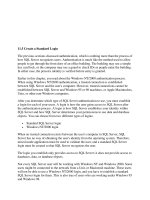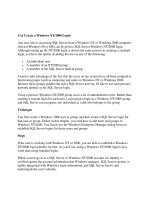Create a Standard Login
Bạn đang xem bản rút gọn của tài liệu. Xem và tải ngay bản đầy đủ của tài liệu tại đây (20.14 KB, 3 trang )
11.5 Create a Standard Login
The previous sections discussed authentication, which is nothing more than the process of
how SQL Server recognizes users. Authentication is much like the method used to allow
people to get through the front door of an office building. The building may use a simple
key card lock, or the company may use a guard to check IDs as people enter the building.
In either case, the person's identity is verified before entry is granted.
Earlier in this chapter, you read about the Windows NT/2000 authentication process.
When using Windows NT/2000 authentication, a trusted connection is established
between SQL Server and the user's computer. However, trusted connections cannot be
established between SQL Server and Windows 95 or 98 machines, or Apple Macintoshes,
Unix, or other non-Windows computers.
After you determine which type of SQL Server authentication to use, you must establish
a login for each of your users. A login is how the user gains access to SQL Server after
the authentication process. A login is how SQL Server establishes your identity within
SQL Server and how SQL Server determines your permissions to use data and database
objects. You can choose from two different types of logins:
•
Standard SQL Server login
•
Windows NT/2000 login
When no trusted connection exists between the user's computer in SQL Server, SQL
Server has no way of obtaining the user's identity from the operating system. Therefore,
mixed mode application must be used to validate the user, and a standard SQL Server
login must be created so that SQL Server recognizes the user.
The login you establish only provides access to SQL Server; it does not provide access to
databases, data, or database objects.
Not every SQL Server user will be working with Windows NT and Windows 2000. Some
users might be connected to the network from a Unix or Macintosh machine. These users
will not be able to use a Windows NT/2000 login, and you have to establish a standard
SQL Server login for them. This is also true of users who are working under Windows 95
and Windows 98.
Technique
SQL Server Enterprise Manager provides the dialog boxes that are necessary to set up
standard logins. This section describes these dialog boxes and how to provide the
information necessary to create standard SQL Server logins.
Creating a login can affect only one person or a group of people; it does not affect how
SQL Server operates.
Steps
If the user is connecting to SQL Server from a Unix, Macintosh, or other non-Windows
machine, or if the user is running Windows 98, you must create a standard login for him.
SQL Server maintains a record of each person's logins and a table named sysxlogins in
the master database. This table stores the user's login ID, encrypted password, and other
critical information. If you'd like to view the data in this table, use the syslogins view in
the master database. The syslogins view uses a SQL statement to arrange the data in a
more readable format.
As the user logs in, regardless of which authentication mode he uses, his user information
is compared against the data that is stored in the syslogins table. As long as the user
appears to be valid, SQL Server allows him to try to access tables, stored procedures, and
data.
1. Open Enterprise Manager and select your server.
2. Use the plus sign (+) next to your server's name to expand the server's object list.
Then expand the security icon.
3. Right-click on the Login icon and select New Login from the shortcut menu.
4. You'll now see the new Login dialog box (see Figure 11.10). Enter the new login
name in the Name text box.
Figure 11.10. Add new Windows NT/2000 logins with the SQL Server Login
Properties dialog box.
5. Select the SQL Server Authentication option button, and enter a password for the
login.
6. Select which database this login will normally use from the Database drop-down
list in the Default section near the bottom of the New Login dialog box.
Comments
The SQL Server standard login does not permit you to use the user's NT/2000 identity.
Therefore, you cannot take advantage of a user's membership in a Windows group to
simplify login creation. You can, however, create a shared login. (CS would be named
something like Marketing for accounting practices used by everyone who is a member of
that group.) The problem is that everyone within that group will use the same password in
login name, which might make security an issue.









